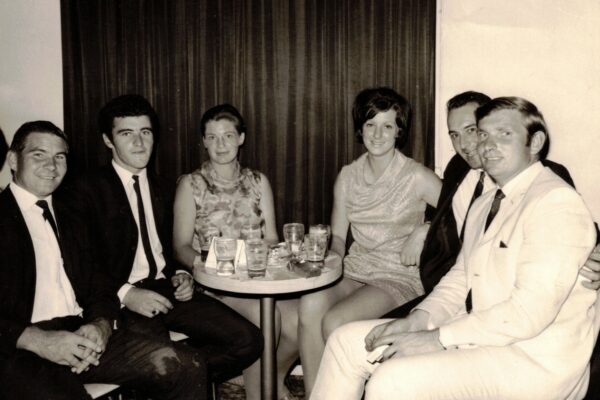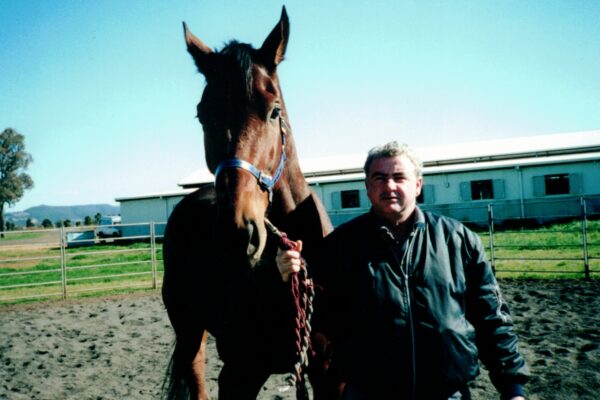Our Forgotten Racecourses
Featured Image: ‘Wallabadah Races’ NSW: “Into the straight”. This racetrack is now abandoned.
John Ryan: AJC Racing Calendar 1991
“The universal love of horseracing in Australia is shown by the large number of meetings every year. There is scarcely a township in any one of the colonies, which has not its annual event. The principal reason for this is the abundance of good horseflesh and the number of good riders as there are few persons residing in the country who cannot mount a saddle. Under such circumstances a love of the turf is natural.” Australian Sportsman 1881
Looking out of a plane window when on a flight over inland Australia the wide open landscape is here and there dotted by towns and settlement linked by a ribbon of road or railway. While it is hard to distinguish particular features from the high flying aeroplane, one feature that does stand out on the perimeter of these inland settlements is a circle of open space marking out the racecourse.
In Australia’s early history, as population extended into the inland the signs of early settlement, the Church, school and pub, were often followed by the racecourse – evidence of advancing civilisation as one Governor wrote to his superiors in London.
By the second half of the century after the land had been taken up and the gold discoveries had brought a new population into the bush, horse transport was the means of lining these settlements with the larger towns and the city.
Along with the horses came the sport of horse racing which soon became the focus of social life, sport and entertainment in those scattered communities. By the end of the first century the racecourse was part of the topography of every town of any size and some of the larger grazing properties and sheep stations laid down their own racecourses for their annual or picnic race meetings.
Said the Australian Sportsman in 1881 commenting on the ‘national sport’:
“The universal love of horseracing in Australia is shown by the large number of meetings every year. There is scarcely a township in any one of the colonies, which has not its annual event. The principal reason for this is the abundance of good horseflesh and the number of good riders as there are few persons residing in the country who cannot mount a saddle. Under such circumstances a love of the turf is natural.”
Just how many race meetings were held in the colony of NSW a hundred years ago is difficult to know as there was no official calendar to record them. Notices are found in local and district papers or in such sporting publications as the Australian Sportsman or Bells Sporting Life giving long list so meetings “To Come Off”, or the Race Card and Results of meetings held up country, or down the coast, or in the mining, river and timber towns. One way to celebrate such occasions as the Queen’s Birthday or St Patrick’s Day was to hold a race meeting. Clubs were formed to hold Annual meetings, or a race meeting was put on for such occasions as the end of the shearing, the arrival of the railway, or for Easter or Christmas holiday.
Commenting on the widespread popularity of the ‘national sport’ the Sydney Morning Herald in 1887 reported despite the hot dry summer conditions, “in this colony no less than 66 fixtures appear on the lists for the Christmas and New Year holidays, besides numerous meetings in less popular parts”. Just as some comparison the AJC Calendar for the last year lists the number of meetings in NSW over this holiday period as 46.
Although it may come as a bit of a surprise to some, there seems little doubt that there was more racing in the colony of NSW one hundred years ago than there is today. Looking through the early lists and notices we come across many racecourses and clubs no longer appearing in our present Calendar and are led to wonder where have they gone: Barmedman – Tinonee – Belimpopina – Monaro – Bokhara – Cannonbar – Nettelgo – Moombi – Wombat – Ivanhoe – Murrumburrah – Adelong Crossing – Patrick Plains – Rutherford – Carcoar – Marsden – Hillend – Berrima – Clarence Town – Macquarie Fields – Mitchell – Sunny Corner – Lower Manning – Breeza or Peel River.
The lost racecourses listed in the Racing Chronicle were not all bush settlements or country courses. There were racecourse in our cities and larger country towns that are no longer there today. Besides the Sydney courses now gone, notices appear for meetings at Liverpool, Parramatta, Windsor, and Wollongong, while larger towns such as Albury, Goulburn, Wagga or Tamworth may have had four or more courses in the surrounding district each with its own club.
How do we recapture now that world when a trainer set off on the road to walk his horses to the course, when the women got dressed up in their best, and when the publican put up his booth to keep the kegs in the shade on the morning of the races.
What has happened to all these departed racecourses many of which are now simply traces of a pst ear left behind by a few panels of railing, a furlong post or a judge’s box left standing in a paddock. Many have disappeared form the landscape altogether and are now the present site of a housing development, a school, or public estate in an extending town perimeter. For some their fate was sealed by drought or floods, some went out in wartime or in the economic dry creek bed of the Depression. Some were also victims of the human condition when the club lost its energy or money or broke up in feuding rivalry. And some were simply part of the larger process of change in Australia’s history itself when the gold mines cut out, when the railway bypassed the district, or when the town went into decline. If it was not for an old newspaper notice or surviving Race Card we might never know that back in the past the starter once dropped his flag on a race meeting at Sunny Corner, Piper’s Flat or Bimbi or in years to come at Wallabadah (still going strong).
One such town caught in this billabong of Australian history is Trunkey Creek, on the road from Goulburn to Blayney was a hundred years ago a thriving gold and horse staging town. The gold discoveries in the Turon District brought miners and their suppliers to the town. As a stopping place for horse traffic from Goulburn to Bathurst, Blayney and Abercrombie there was plenty of business for the inns and hotels which in Trunkey’s heyday numbered 23, of which 7 held licences. All the inns had horse and grooming services, which along with the other town services saw Trunkey in its balmy days, grow to a population of 2500. That a racecourse would be set-up and race meetings organised for such a population of itinerant and gambling spirits was as inevitable as a prayer meeting for pilgrims. The racecourse was situated out of town along the Blayney road and on a property now known as “Tara” and notices of race meetings at Trunkey Creek began to appear in Town and Country Journal in the late 1880s.
In 1888 when the Centenary of the Colony came round, most towns organised their own celebrations. Trunkey Creek’s celebration was to put on a Centenary race meeting. This was to be no local hack meeting for its 2-Day Centenary Meeting headed the list of Centenary races in Bells Racing Life in the Sydney Mail. On the card for the first day were 5 races including the Centennial Handicap of 30 sovs, and the Prince of Wales Stakes and on the second day another 5 races with the feature event The Trunkey Jockey Club Handicap of 20 sovs. The rules under which the Club raced were AJC rules as far as practicable. Just how this was interpreted at Trunkey Creek may be left to our imagination.
Like most country towns around that era there was always a character of sorts and the Trunkey Creek lot fell to one Mathew Ryan.
Mathew Ryan, an Irish immigrant from Tipperary had taken up land at Long Swamp near Trunkey where he tried to make a go of it with his wife and 8 children. He was no farmer however but a man with horses and travelled with horse transport to Sydney and up country and rode around the district as a jockey. Another who was probably there was Paddy Crick the future MP for West Macquarie. Paddy was a renowned racehorse owner and punter, (Banjo tells of riding one of Paddy’s horses at Randwick and the size of the wager). Paddy was courting the Irish voters of Trunkey for his coming election.
Mathew Ryan as a boy groomed his black thoroughbred, which in his election campaign he promised to the local priest if he was elected. As it turned out it was shrewd election promise, W P Crick was returned, as the Member for Trunkey Creek, with I should think, a very strong return from the residents of the heavily endowed Catholic community.
The 1888 Centenary Meeting may well have marked the zenith in Trunkey Creek’s fortunes for within a few years the town was on the road to decline. The railway line to Newbridge cut Trunkey out as travellers’ stopover and horse staging town and when gold ran out so did the life and fortunes of Trunkey Creek.
When the first AJC Register was published in 1900 the Trunkey Creek Club was not listed. Today the town is just a small cluster of settlements either side of the pub along the once bust road to Goulburn. There are just a few relics of the racecourse still left on the property of Mr Robbins at “Tara”.
Thought the racing days of these vanished racecourses have gone they are all part of the history and tradition which gives to Australian racing its own special character. They too are art of our national legends and literature. It was at the Bogolong racecourse that Pardon won the Cup. There is, and always will be, a special place for the “bush” whether it be a bush meeting, a bush horse or a “bushie” coming to town to take on the racing world of the city. It is all part of the past, which has formed not only the tradition of our racing life but Australian life itself.
When asked by the Bishop in John O’Brien’s poem why Christmas was the greatest day of the year the youngster gives an answer no Bishop ever knew:
It was the day before the races at Tangmalangaloo.
Though the old course may be gone its life lives on.
An Idyll of Dandaloo
On Western Plains, where shade is not,
‘Neath summer skies of cloudless blue…
The yearly races mostly drew
A lively crowd to
Dandaloo










